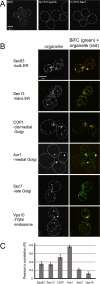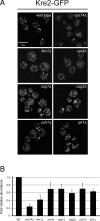Local control of phosphatidylinositol 4-phosphate signaling in the Golgi apparatus by Vps74 and Sac1 phosphoinositide phosphatase
- PMID: 22553352
- PMCID: PMC3386216
- DOI: 10.1091/mbc.E12-01-0077
Local control of phosphatidylinositol 4-phosphate signaling in the Golgi apparatus by Vps74 and Sac1 phosphoinositide phosphatase
Abstract
In the Golgi apparatus, lipid homeostasis pathways are coordinated with the biogenesis of cargo transport vesicles by phosphatidylinositol 4-kinases (PI4Ks) that produce phosphatidylinositol 4-phosphate (PtdIns4P), a signaling molecule that is recognized by downstream effector proteins. Quantitative analysis of the intra-Golgi distribution of a PtdIns4P reporter protein confirms that PtdIns4P is enriched on the trans-Golgi cisterna, but surprisingly, Vps74 (the orthologue of human GOLPH3), a PI4K effector required to maintain residence of a subset of Golgi proteins, is distributed with the opposite polarity, being most abundant on cis and medial cisternae. Vps74 binds directly to the catalytic domain of Sac1 (K(D) = 3.8 μM), the major PtdIns4P phosphatase in the cell, and PtdIns4P is elevated on medial Golgi cisternae in cells lacking Vps74 or Sac1, suggesting that Vps74 is a sensor of PtdIns4P level on medial Golgi cisternae that directs Sac1-mediated dephosphosphorylation of this pool of PtdIns4P. Consistent with the established role of Sac1 in the regulation of sphingolipid biosynthesis, complex sphingolipid homeostasis is perturbed in vps74Δ cells. Mutant cells lacking complex sphingolipid biosynthetic enzymes fail to properly maintain residence of a medial Golgi enzyme, and cells lacking Vps74 depend critically on complex sphingolipid biosynthesis for growth. The results establish additive roles of Vps74-mediated and sphingolipid-dependent sorting of Golgi residents.
Figures







Similar articles
-
PtdIns4P recognition by Vps74/GOLPH3 links PtdIns 4-kinase signaling to retrograde Golgi trafficking.J Cell Biol. 2009 Dec 28;187(7):967-75. doi: 10.1083/jcb.200909063. Epub 2009 Dec 21. J Cell Biol. 2009. PMID: 20026658 Free PMC article.
-
Sac1-Vps74 structure reveals a mechanism to terminate phosphoinositide signaling in the Golgi apparatus.J Cell Biol. 2014 Aug 18;206(4):485-91. doi: 10.1083/jcb.201404041. Epub 2014 Aug 11. J Cell Biol. 2014. PMID: 25113029 Free PMC article.
-
PtdIns4P restriction by hydrolase SAC1 decides specific fusion of autophagosomes with lysosomes.Autophagy. 2021 Aug;17(8):1907-1917. doi: 10.1080/15548627.2020.1796321. Epub 2020 Jul 30. Autophagy. 2021. PMID: 32693712 Free PMC article.
-
Growth and metabolic control of lipid signalling at the Golgi.Biochem Soc Trans. 2012 Feb;40(1):205-9. doi: 10.1042/BST20110637. Biochem Soc Trans. 2012. PMID: 22260691 Review.
-
Coordination of Golgi functions by phosphatidylinositol 4-kinases.Trends Cell Biol. 2011 Feb;21(2):113-21. doi: 10.1016/j.tcb.2010.10.002. Epub 2010 Nov 4. Trends Cell Biol. 2011. PMID: 21282087 Free PMC article. Review.
Cited by
-
Neo1 and phosphatidylethanolamine contribute to vacuole membrane fusion in Saccharomyces cerevisiae.Cell Logist. 2016 Aug 25;6(3):e1228791. doi: 10.1080/21592799.2016.1228791. eCollection 2016 Jul-Sep. Cell Logist. 2016. PMID: 27738552 Free PMC article.
-
Regulation of V-ATPase Activity and Organelle pH by Phosphatidylinositol Phosphate Lipids.Front Cell Dev Biol. 2020 Jun 23;8:510. doi: 10.3389/fcell.2020.00510. eCollection 2020. Front Cell Dev Biol. 2020. PMID: 32656214 Free PMC article. Review.
-
Study of GOLPH3: a potential stress-inducible protein from Golgi apparatus.Mol Neurobiol. 2014 Jun;49(3):1449-59. doi: 10.1007/s12035-013-8624-2. Epub 2014 Jan 7. Mol Neurobiol. 2014. PMID: 24395131 Review.
-
A Golgi Lipid Signaling Pathway Controls Apical Golgi Distribution and Cell Polarity during Neurogenesis.Dev Cell. 2018 Mar 26;44(6):725-740.e4. doi: 10.1016/j.devcel.2018.02.025. Dev Cell. 2018. PMID: 29587143 Free PMC article.
-
Structural genomic variation as risk factor for idiopathic recurrent miscarriage.Hum Mutat. 2014 Aug;35(8):972-82. doi: 10.1002/humu.22589. Epub 2014 Jun 24. Hum Mutat. 2014. PMID: 24827138 Free PMC article.
References
-
- Bretscher MS, Munro S. Cholesterol and the Golgi apparatus. Science. 1993;261:1280–1281. - PubMed
Publication types
MeSH terms
Substances
Grants and funding
LinkOut - more resources
Full Text Sources
Molecular Biology Databases

